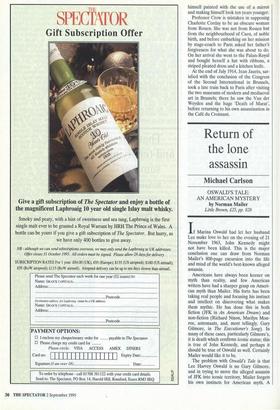That hot and terrifying summer
Richard Cobb
EMULATION: MAKING ARTISTS FOR A REVOLUTIONARY FRANCE by Thomas Crow Yale, 129.95, pp. 288 Like all publications of the London branch of Yale University Press, Professor Crow's study of David, his two closest and most cherished pupils, Drouais and Girodet and their successors, is a magisteri- al contribution to the history of art, which in this particular case is a history somewhat apart. His study is deeply researched, with 'Always check your flies before you go out, son.' many tributes to 'mode-breaking' and 'hybrid zones of discourse'. His observa- tions are applied with brilliant precision to the minutest details of movement or body- stance in each of the paintings submitted to his examination. He is not modest in his claims, no doubt rightly so, for his com- mentary on David and on his young pupils is based on formidable specialist analysis, mostly recent and much of it American.
However, to anyone familiar with the political history of France, especially between 1789 and 1795, something is lack- ing in this approach, admirable though it is in range of reference. From the time of the formation of the Revolutionary Govern- ment in March-April 1793 (composed of the Committee of Public Safety, Commit- tee of General Security and the Revolu- tionary Tribunal), David was a member of the Committee of General Security. It took the present reviewer two years to work through its massive papers; nearly all the arrest warrants that concerned Parisians were signed by David, who was the only native-born Parisian among all 24 members of the two Committees. A great many of those thus consigned to arrest, prior to appearing before the Revolutionary Tri- bunal, were fan-makers, peintres d'histoire, printers and other artisans in the lower ranks of the visual arts. David, the master of a school that spread from Paris to Rome, and that later managed to survive in France under the Directory and the Empire, seems also to have had plenty of time to devote to his daily work as political policeman.
This must raise the whole issue of David's relationship to Robespierre. The author refers to Robespierre's 'violently paranoid drive for purity in May 1794' and he makes further reference to 'Robespierre's increasingly philistine attacks on intellectuals', whoever they were or whatever he may mean in terms of Robespierre's frequently re-iterated death- wish during that hot and terrifying summer. Much the most interesting hypothesis of what may have led to the crisis of 9-10 Thermidor is the plan worked out for the proposed festival of the boy-hero and martyr, Bara, 'an imaginary Utopia of unblemished boys'. The fête was to begin at 5 p.m. so that the gathering darkness would hide the conspirators, but at the last moment David tried to head off the crisis by announcing that the fête would start at 9 a.m. What gives coherence to this claim is that David's colleague, Le Bas, an intimate member of the Robespierre household, was at the time Commandant of the Ecole de Mars, the military school situated in the plaine des Sablons in the Bois de Boulogne where it was feared that the purity of the untarnished Martians might be impaired by the presence of prostitutes. In any case, the heroic boys never turned up, Robespierre and his colleagues achieved their death wishes, David went to prison for a few months, re-emerging with a portrait of himself painted with the use of a mirror and making himself look ten years younger.
Professor Crow is mistaken in supposing Charlotte Corday to be an obscure woman from Rouen. She was not from Rouen but from the neighbourhood of Caen, of noble birth, and before embarking on her mission by stage-coach to Paris asked her father'S forgiveness for what she was about to do. On her arrival she went to the Palais-Royal and bought herself a hat with ribbons, a striped pleated dress and a kitchen knife.
At the end of July 1914, Jean Jaures, sat- isfied with the conclusion of the Congress of the Second International in Brussels, took a late train back to Paris after visiting the two museums of modern and mediaeval art in Brussels; there he saw the Van der Weyden and the huge 'Death of Marat', before returning to his own assassination in the Cafe du Croissant.



















































 Previous page
Previous page